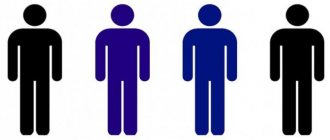Lesson plan:
Man's place in society
Prescribed and achieved social status
Variety of social roles
Social roles and age
Reasons for the generation gap
Society places different expectations on teachers, doctors, parents and children, political scientists and economists, girls and boys. All of these listed positions represent diverse social statuses.
Man's place in society
Society consists of numerous groups of people, public organizations, and individuals connected by relationships. These relationships are regulated by social norms - rules of behavior accepted in society. But these rules are not the same for everyone; what is possible for some people is prohibited for others.
A police officer can carry a weapon and use force against violators of public order, but this does not mean that all other members of society have such rights. Social statuses and social roles help people understand their diverse rights and responsibilities. They depend on the age, financial and marital status of the individual, level of education, and profession. Social statuses and roles change as a person grows up, his career grows, and he gains access to power.
Social status is the position occupied by an individual in society. This provision imposes on the individual a number of responsibilities, rights, and privileges.
Example.
- Alexandra Ivanovna is a seller, this is one of her social statuses. It imposes certain responsibilities on a woman: to be in the store from 8 a.m. to 6 p.m., sell people various products, advise customers on the quality or other characteristics of products. Along with her responsibilities, Alexandra Ivanovna has the rights to receive wages, take paid leave once a year, and go on sick leave in case of health problems.
- Sasha Ivanov is a seven-year-old child, this characteristic is the social status of a person. Sasha has the rights: to the care of his parents, their love, to provide him with clothes, food, toys, books and everything that Sasha needs. But along with rights, Sasha has some responsibilities: obey his parents, study at school.
- Vladimir Alekseevich is a grandfather - this is one of his social statuses. Vladimir Alekseevich has the right to see his grandchildren, buy them gifts, and share his life experience with them. His responsibilities include taking care of his grandchildren when their parents are not around.
The same individual may have several dozen social statuses, which impose on him certain rights and responsibilities. Each social status has its own manner of behavior, which is called a social role . Even by the clothes an individual is wearing, one can understand his social role and expect certain behavior from him in society. Seeing a military uniform, a doctor's robe, or a formal business suit, one can guess about the social status of a given individual.
This is interesting! In the recent past, about 200 years ago, one could understand from women’s clothing whether a woman was married or not, what her family’s income was, what social class she was from, where she was from. Time has changed and today the rules for wearing clothes are no longer so strict, but a person’s appearance can still tell about several social roles of an individual.
Concept
Social status is a position in the social structure. The term is used in 2 meanings:
- The social status of an individual is a person’s position in society, in the system of social and interpersonal relations. It is reflected in the internal position (values and orientations, motivations), in external appearance, speech culture, jargon.
- The social status of a group is the place occupied by the group in the social hierarchy. Status groups are characterized by a specific system of values, norms of behavior, a certain lifestyle, type of education and occupation.
The concept includes:
- assessment by an individual or a group of their place in the social hierarchy;
- public assessment of the activities of an individual or group.
Social status is determined by socially significant characteristics :
- natural – ethnic, age, gender;
- economic – property and financial status, lifestyle;
- social settlement – city dwellers, rural residents;
- set of rights, obligations, functions;
- place in the hierarchy of political relations - possession of power, activity in political groups, organizations, movements;
- place in the division of labor system - education, type of employment, profession, qualifications;
- prestige - the social significance of a position occupied in society.
The combination of all these characteristics determines social position . The system of social statuses forms the laws of interaction (rights and obligations, hierarchy of subordination) of individuals and groups.
Prescribed and achieved social status
There are several types of social statuses:
- Prescribed;
- Found;
- Achievable.
a prescribed status from birth; he cannot choose it on his own. When a child is born, he or she acquires nationality, race, gender, and age. In some cases, certain titles and titles may pass to a person by birth. But sometimes the prescribed social status may change.
Example. Alina Sidorova is Russian by nationality, this is her innate status. But at the age of 2, Alina left with her parents for America, where over time she and her entire family received American citizenship. Alina lived all her life in the USA and forgot the Russian language, did not know about Russian customs and traditions, in this case her prescribed social status changed.
Acquired status is a status that has changed under the influence of life circumstances and was obtained under certain conditions.
Example. Nadezhda Petrovna - Dima's mother. When Dima turned 30, he married Svetlana. Because of these life circumstances, Nadezhda Petrovna, against her will, acquired a new social status - mother-in-law.
the achieved social status through his own efforts. A person sets a goal for himself, depending on his desires, and achieves it. Through your own efforts, you can improve your financial situation, get a higher education, master a new profession, and gain power in society. But the acquired social status does not always completely depend on the desire or reluctance of the individual; luck and the innate capabilities and abilities of the individual play a certain role.
Examples of achieved social statuses: student, professor, president, parent, general, priest.
Hierarchy of statuses
Statuses in the social structure are unequal. In the public consciousness, individuals and groups are compared according to their status characteristics and are arranged in a hierarchical order. The social prestige of statuses and their hierarchy are formed under the influence of the following factors:
- the real significance of a particular status for society;
- system of values historically developed in a given culture.
Hierarchy types:
- intergroup – covers different groups within society;
- intragroup – ranks individuals within one group.
The position of a status in a hierarchy is called status rank. It determines the level of this status - high, medium or low. The plurality of individual statuses often gives rise to their discrepancy (inconsistency). It manifests itself in cases where a person occupies different status positions in different social groups and he has to perform conflicting functions, rights and responsibilities.
The concept of social status is related to the concept of social role. However, there are significant differences between them. If social status determines the place a person occupies in society, then the role characterizes social expectations based on this status. In situations of discrepancy, inconsistency of statuses, a role conflict may arise.
Variety of social roles
Each status determines the behavior of the individual and gives him one or more roles. Roles arise spontaneously, as a result of interpersonal communication in a team, or are created on the basis of social norms, requirements for the position occupied by an individual in society. Human social roles are divided into:
- Formal - associated with profession, study, exercise of power in society;
- Interpersonal – determine the behavior of people in family, friendships, and interest groups;
- Gender roles are rules of behavior assigned in society to different sexes: women and men;
- Age - depends on the number of years a person has lived;
- Demographic – roles assigned to various nations, ethnic groups, and peoples.
Depending on a person’s social status, society expects him to fulfill all social roles.
Example. Vasya Fedorov is 13 years old. His social roles at school: study, self-affirmation, competition in school competitions, preparing homework, participation in interdisciplinary quizzes, being on duty in the classroom, obedience to teachers. Social roles in the family: fulfilling the demands of parents, helping parents around the house, studying, taking care of pets. As Vasya grows up, he will have new social statuses and, in accordance with them, types of social roles.
The roles a person performs shape his image. Image is an image of a person, consisting of ideas about how she should dress, speak, look, and behave in society. Representatives of professions respected in society try to look properly in the eyes of others, take care of their appearance, follow the rules of etiquette, and adhere to certain social norms.
Example. Teachers do not allow themselves to come to lessons in shorts and a T-shirt; they wear clothes in strict colors and adhere to business attire. In addition, teachers know that they are role models for students, so they always try to speak politely, competently, and follow the rules of etiquette. At the same time, the social roles of the teacher change when he comes home from work to his family. There he is a husband, a father, and a slightly different style of clothing and behavior is expected of him. Consequently, social statuses determine social roles.
Status hierarchy
Social status is considered in two orientations (R. Budon):
- horizontal - status built on a system of social contacts, real and acceptable, assigned between the holder of the status and other individuals in an identical social position;
- vertical - status built on a system of social contacts and mutual exchanges developing between status holders and people of a different social level.
Status hierarchy is inherent in any social group, the interaction of whose members is real only due to their acquaintance. At the same time, the official structure of the organization may differ from the unofficial one. Official social status is largely determined by qualifications, personal qualities, charm, etc.
Note 2
Functional dissonance may arise between functional and hierarchical status.
Status confusion is a parameter of social disorganization, as a result of which deviant behavior can develop.
Violation of status functioning and interaction can take two forms (E. Durkheim):
- on the basis of an individual’s social status, his expectations become uncertain and the reciprocal expectations of other people also become uncertain;
- instability of social status affects the degree of individual life satisfaction and the structure of social rewards.
Social roles and age
Each age group has its own social status and social roles. The main age groups are:
- Infancy;
- Preschool age;
- Junior school age;
- Adolescence;
- Youth;
- Maturity;
- Average age;
- Elderly age;
- Old age.
Depending on a person's age, society expects appropriate behavior from an individual. For example, teenagers would look ridiculous crying loudly in a store and asking their parents to buy them a toy.
Of all ages, the transitional age is special, falling on the period from 12 to 15 years. During these years, the child is already leaving childhood behind and is just beginning to master the social roles of a teenager. A teenager acquires new social statuses in a group of peers, family, sports clubs and interest groups, and a group of friends. Along with the acquisition of new statuses, there is a rapid development of social roles in adolescence.
In addition, during adolescence, young people begin to learn gender roles in society. Girls learn to cook, sew, take care of younger family members, begin to use cosmetics, and acquire their first communication skills with the opposite sex. Boys learn to handle various household tools and master self-defense skills.
Diversity of social roles in adolescence:
- Son daughter;
- Leader/outcast;
- Brother/sister;
- Housewife/host;
- Pupil/student;
- Athlete/athlete;
- Boyfriend/girlfriend;
- Reader/Writer;
- Video blogger;
- Excellent student/good student/C student;
- Boy/girl;
- Conscript (for the military registration and enlistment office);
- Artist;
- Musician;
- Dancer.
For deviation from the role expectations prescribed by society for a teenager in connection with his social status, society can punish him with disapproval, the introduction of prohibitions and additional requirements.
Example. Marina Nikolaeva is the class leader. This social status of a teenager prescribes a certain type of behavior for Marina: she must set an example for her classmates, be responsible, not skip school, and be responsible for the safety of the school magazine. Recently, Marina persuaded her classmates to skip a physics test. The whole class immediately agreed. It turned out that they skipped not an ordinary test, but an important section of knowledge for the 8th grade. The class teacher found out about this incident and Marina’s misconduct and appointed another head teacher in her place as punishment for what she had done.
Achieved status
This is what a person achieves himself. By making efforts, making choices, working, studying, each individual ultimately comes to certain results. His successes or failures are reflected in the way society assigns him the status he deserves. Doctor, director, company president, professor, thief, homeless person, tramp.
Almost every achieved social status of an individual has its own insignia. Examples:
- for the military, security forces, internal troops - uniform and shoulder straps;
- doctors wear white coats;
- people who have broken the law have tattoos on their bodies.
Reasons for the generation gap
Young people and teenagers are often offended by the older generation for the many prohibitions and restrictions imposed on them. Psychologists call this a breakdown of connections between generations. But when parents forbid teenagers from watching TV, playing computer games, drinking alcohol, or staying in the company of friends, they are simply fulfilling their social roles. Parents are strict not out of harshness or lack of love towards their children, but out of duty towards them.
Teenagers dream of growing up faster, they promise themselves never to act in the same way towards their future children, they dream that when they become adults, they will allow their children to do whatever they want. But having matured, teenagers change their view of the world and, having become parents, also show some severity towards their children. The problem of a breakdown in communication between generations leads to a lack of mutual understanding between older and younger ones. To fix this, everyone needs to try to put themselves in the other’s place.
Meaning of the term and general characteristics
The word “status” itself dates back to Ancient Rome. Then it had more of a legal connotation, rather than a sociological one, and denoted the legal status of an organization.
Nowadays, social status is a person’s position in a particular group and society as a whole, giving him certain rights, privileges, as well as responsibilities in relation to other members.
It helps people interact better with each other. If a person of a certain social status does not fulfill his duties, then he will be held responsible for it. Thus, an entrepreneur who sews clothes to order will pay a penalty if the deadlines are missed. In addition, his reputation will be ruined.
Examples of the social status of one person are a schoolboy, son, grandson, brother, member of a sports club, citizen, and so on.
This is a certain characteristic of a person according to his professional qualities, financial and marital status, age, education and other criteria.
A person can simultaneously belong to several groups at once and, accordingly, play not one, but many different roles. That's why they talk about status sets. It is unique and individual for each person.
Can a person have no social status?
Any individual has a couple of three statuses, which are absolutely impossible to lose. One will be replaced by another replacing him. A schoolchild, having completed the eleventh grade, becomes a student. A citizen who buys real estate turns from a buyer into an owner. He was the chief physician, was promoted, and became deputy minister of health.
The more social positions a person has, the more diverse and interesting his life.
Prestige
Not the least role in the destinies of people is played by such a concept as prestige (and positive, from the point of view of the majority, social status). We can easily find examples in the questionnaire that students of all high schools write before entering higher education institutions. They often make their choice based on the prestige of a particular profession. Nowadays, few boys dream of becoming an astronaut or pilot. And once upon a time it was a very popular profession. They choose between lawyers and financiers. This is how time dictates.
Conclusion: a person develops as an individual in the process of mastering different social statuses and roles. The brighter the dynamics, the more adapted to life the individual will become.











